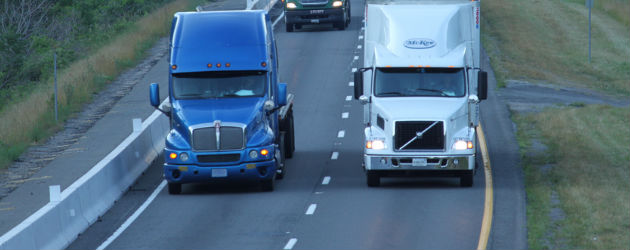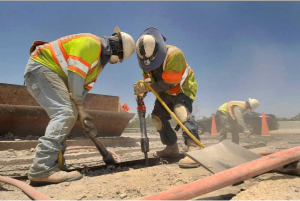Study predicts $365 billion highway fund shortfall
 Courtesy of Better Roads, author Tina Grady Barbaccia: As automobile fuel economy increases, the federal highway program’s fiscal position will become ever more precarious, a new study by researchers at the College of William and Mary finds.
Courtesy of Better Roads, author Tina Grady Barbaccia: As automobile fuel economy increases, the federal highway program’s fiscal position will become ever more precarious, a new study by researchers at the College of William and Mary finds.
The team from William and Mary’s Thomas Jefferson Program in Public Policy (TJPPP) forecasts that over the next 23 years, as Corporate Average Fuel Economy (CAFE) standards rise, gasoline consumption will decline. This will lead to a drop in gas tax payments to the federal Highway Trust Fund (HTF), the highway program’s primary funding source. Failing to change the existing tax structure while maintaining current investment will cause the HTF’s account to incur a $365.5 billion deficit over the next 23 years, the study concludes.
The highway program is already in dire straits. Although it has been self-sustaining for many years thanks to the gas tax and other user fees, declining revenues have made transfers from the general budget necessary to prevent road and bridge spending cuts. Myriad studies have shown that merely maintaining current spending is insufficient to build the infrastructure our growing economy needs. One report by the Texas Transportation Institute found that traffic congestion, resulting in large part from inadequate capacity, costs the country more than $100 billion per year in wasted time and fuel.
“HTF revenues are inadequate to support today’s road and bridge spending levels, which are already well below what’s needed to maintain the interstate system’s performance,” said Christian Klein, vice president of government affairs for Associated Equipment Distributors (AED), which sponsored the research. “As part of the broader tax and budget reform debate, Congress needs to do something bold to put the program back on solid fiscal footing.”
 The William and Mary study offers a few possible solutions. The gas tax was last increased – to 18.4 cents per gallon – in 1993. The research team determined that restoring the gas tax’s 1993 spending power by raising it to 25 cents and indexing it for future inflation would raise $167 billion above current baseline spending requirements over the next two decades. The study also examined ways to implement a vehicle mileage-based user fee.
The William and Mary study offers a few possible solutions. The gas tax was last increased – to 18.4 cents per gallon – in 1993. The research team determined that restoring the gas tax’s 1993 spending power by raising it to 25 cents and indexing it for future inflation would raise $167 billion above current baseline spending requirements over the next two decades. The study also examined ways to implement a vehicle mileage-based user fee.
“We hope Congress will take these findings to heart and act quickly to identify new and expanded revenue streams for the road program,” AED President and CEO Toby Mack said. “Highways are the arteries of commerce and the arteries are clogged. The longer lawmakers wait to tackle the problem, the worse it’ll get and the harder it’ll be to fix.”
“HTF revenues are inadequate to support today’s road and bridge spending levels, which are already well below what’s needed to maintain the interstate system’s performance,” said Christian Klein, vice president of government affairs for Associated Equipment Distributors (AED), which sponsored the research. “As part of the broader tax and budget reform debate, Congress needs to do something bold to put the program back on solid fiscal footing.”
The William and Mary study offers a few possible solutions. The gas tax was last increased – to 18.4 cents per gallon – in 1993. The research team determined that restoring the gas tax’s 1993 spending power by raising it to 25 cents and indexing it for future inflation would raise $167 billion above current baseline spending requirements over the next two decades. The study also examined ways to implement a vehicle mileage-based user fee.
“We hope Congress will take these findings to heart and act quickly to identify new and expanded revenue streams for the road program,” AED President and CEO Toby Mack said. “Highways are the arteries of commerce and the arteries are clogged. The longer lawmakers wait to tackle the problem, the worse it’ll get and the harder it’ll be to fix.”
American Road & Transportation Builders Association (ARTBA) President & CEO Pete Ruane said in a written statement commenting on the Texas Transportation Institute’s “Urban Mobility Report” that “Washington, D.C., has the dubious distinction of being number one in two areas. It is the capital of partisan gridlock, and now traffic gridlock.”
Ruane says the finding in the Texas Transportation Institute report that America’s transportation network is “more unreliable isn’t a surprise to the millions of motorists who slog through bumper-to-bumper traffic in cities of all sizes, or to the businesses attempting to move their goods and services.”
However, the real news is the projection that traffic congestion costs will balloon another 65 percent by 2020 if the status quo is maintained. “The number of hours of lost time will also skyrocket 55 percent,” Ruane says.
“While we may have to accept deadlocked politicians, there are ways to get Americans moving again. Robust new investments aimed at creating additional highway and public transit capacity, and providing more travel options could help accelerate economic recovery and better prepare the nation for the 21st century mobility challenges that come with it.”
The full report in a PDF format can be accessed at http://www.aednet.org/government/pdf-2013/WM-HTF-Report.pdf.
Category: Featured, General Update, News










